While Ellen toils this week in Toronto I'm in Latin America, a guest of the Costa Rica Tourist Board.
Three American journalists and I were invited to do a familiarization trip focusing on extreme sports. I could have written about what it's like to rappel down a seventeen metre waterfall, get tossed out of an inner tube in class IV rapids, or whitewater raft down the treacherous Pacuare River. Instead though, today's lesson will focus on flora and fauna.
Leaf cutter ants scurry about the forest on trails they've made for themselves carrying bits of leaf that are approximately ten times their own size. Although I've seee them many times before I never had a clue of their goal. Here's how it works: The leaf cutters aren't leaf cutters at all, but simply carriers. To show the strength of the carriers, Massi our tour guide, picked up one of the one-centimetre carriers, held it between his fingers, and then placed a stick of about twenty-five centimetres up to its undercarriage. This tiny creature held the stick for almost ten seconds before dropping it to the ground. But there's far more to this nature tale.
The first ant, or actual 'leaf cutter', cuts tiny pieces of fresh green leaf, then the carriers lug them on their backs towards the den. All the while tiny cleaner ants, about a tenth the size of the stronger carriers, walk along the carried leaves cleaning them of bacteria. When the cargo arrives at the den a third ant chews the leaf pieces, and then deposits the leaf goop on the den floor. After a time, fungus grows on the leaves and this becomes food for the entire clan.
Their cousins, the soldier ant, march with much grimmer intent. When they descend on their prey, colonies of other bugs, they circle their hapless dinner, then attack. Apparently, Costa Rican home owners are pleased when their homes are invaded by these little Infantrymen. It means that within a short time their houses will be bug free and the ants will simply move on in search of yet another dinner. But much like the cutters this cycle of life story doesn't stop there. Birds follow soldier ants waiting to eat the scattering bugs as they attempt to fly off in escape.
Butterflies follow the birds around and eat the excrement of the bug filled birds. And everyone thinks butterflies are so pretty. I'll call them lazy, stool eaters from this day on.
During a jungle hike Massi showed us tiny, three centimetre fern-like plants called Mimosa.
"Watch when I touch this plant", he said. "The leaves will shrivel and close right up."
"When I drink five mimosas, I open right up," replied the ever ready wunderkind writer Samantha from Los Angeles.
Once the mimosa feels that the danger has passed it reverts quickly back to its natural form.
Today, while the rest of the group are off climbing up thirty-three hundred metres in the cold rain to look down into the hole of Turrialba Volcano, I'm resting in my cabin reading Carl Hiaasen's novel Tourist Season. I tried to persuade the group leader to do an urban hike through the back alleys of San Jose instead, but it wasn't to be.
.
.
Below is an alternate version of this trip. It was originally published by CanWest. The hard-copy is followed by the National Post link, version.
Should the link go away on its own one day, there will still be the hard copy:
.
.
WATERFALLS, BUT YOU DON’T
Why sit on Costa Rica’s beaches when you can climb its rivers? By Jack Drury
National Post (Latest Edition)7 Feb 2009Weekend Post
.
A menacing chestnut-billed toucan screeches high above. My first step backward off the precipice feels suicidal. My legs are open wide to balance myself as my feet bounce downward once, twice, against the slippery canyon wall. Then a slip, and I’m spinning, banging against the jagged rock. If I look up, I’ll surely take in water, maybe drown. Looking down isn’t much better.
Canyoning is a word that cleverly disguises what I’ve gotten myself into — rappelling down waterfalls. I know it’s safe, has to be safe. But the fact remains, I’m climbing down a powerful 15-metre waterfall on a rope.
Weak-kneed and bleeding only slightly when I reach the riverbed below, I’m shown a digital photo of myself. The big ear-to-ear grin when my feet touch solid ground masks how afraid I was just moments earlier.
The grin disappears when I’m told there are stronger and higher waterfalls not far off.
I climb up a few boulders, then some ladder rungs on an enormous strangler fig tree and the next thing I know I’m hooked to a cable and zooming along a zip-line faster than a panther is moving somewhere deep in the nearby jungle. It’s safe, has to be safe. But fear tells me the lush green forest below and a fast-flowing river are all that will save me when the cable breaks.
Four waterfalls and five zip-lines later, though, it’s mine. I’ve beaten the jungle. Fists hammering off my life-jacket-covered chest, I let out my best Tarzan call.
From a branch high in the forest, the noisy toucan taunts me, as if to say, “There’s still the river.”
Luckily for me, most tourists choose Costa Rica for its sunshine and beautiful beaches. Too often they miss the remarkable inland biodiversity the country has to offer, especially on the Caribbean side. The Turrialba region, with its rolling countryside views, just a two-hour drive east of San José, remains a hidden gem.
Rarely visited Turrialba Volcano National Park, home to its own active volcano, is just 15 kilometres from the town. The volcano hasn’t had a major eruption for more than 140 years. You can climb right to the crater’s edge and peek into its still steaming bowels.
At 3,340 metres, the four-hour trek to the summit is sometimes wet and often chilly — but worth it. On a clear day, other volcanoes — Poas, Barva and Irazu — can be seen along the central valley. But finishing Carl Hiaasen’s Tourist Season is more important to me than a high-altitude hike, so I take the morning off.
Back in the valley, my companions and I hike to the Golden Bean coffee plantation, where experts show us the proper way to make, taste and drink the brew. In the evening, we dine at Turrialtico Lodge, where entrees come smothered in a subtle chocolate sauce.
While the lights are pretty, I’m chomping at the bit. It’s not the food, the coffee or the volcanoes that brought me here. I long for the forest, the wildlife and the treacherous water.
The Pacuare River winds its way from the Talamanca mountain range, the highest in Costa Rica, down to the Caribbean Sea. Rated among the top five rivers in the world for scenery and rapids, it offers nine Class-III and six Class-IV rapids on a 29-kilometre stretch.
After a lecture and some safety training, my companions and I slide our raft into a serene pool at the river’s edge. Tito, our navigator, will issue orders when required. To disobey might mean getting thrown from the raft, maybe even washed all the way to the Caribbean, alone, without a paddle. The babbling toucan does one flyby, then another.
The first three sets of rapids are fun, like an amusement park’s tilt-a-whirl or a low-end log flume ride. A waterfall here, a troop of white-faced monkeys there, an iguana looking down on us from a cactus. Each bend in the river brings a promise of magic. Then Tito points at an approaching Class-IV rapid. He tells us to paddle hard into the centre of the flow. Two blasts of spray, then a tremendous sheet of water envelopes us.
We plunge downward a metre, maybe two, into the whitewater storm. A giant boulder to the left, a churning pool, called a hydraulic, to the right. Tito yells at us to get down. Lying on the floor of the raft, we slide over a rock and into the hydraulic, then spin out and bounce off the boulder. From my full fetal position, I want to suck my thumb. Suddenly, Tito tells us to get up and paddle hard. We climb back to our sitting positions and follow his orders. Soon, the water is calm again.
“ Muy good,” Tito shouts. “High-fives.”
With wide smiles, we raise our paddles to the sky and, in disjointed unison, shout, “ Pura vida!” the rallying cry of Costa Rica.
Three hours and 29 kilometres later, our raft is drifting through a canyon. We jump into the river and, like slow-moving logs, float on our backs. I want to free myself of the life jacket and helmet, then dive deep, catch a fish with my bare hands and eat it raw. For, just like the jungle before it, the river is mine.
As for the toucan, it is nowhere to be seen.

 Turrialba, Province of Cartago, Costa Rica
Turrialba, Province of Cartago, Costa Rica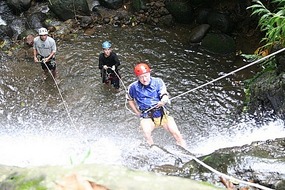
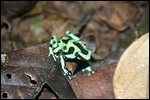
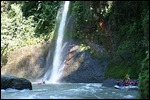
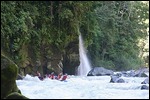
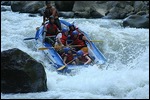
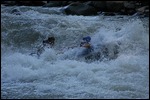
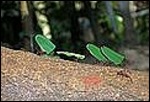
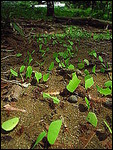












2025-05-22